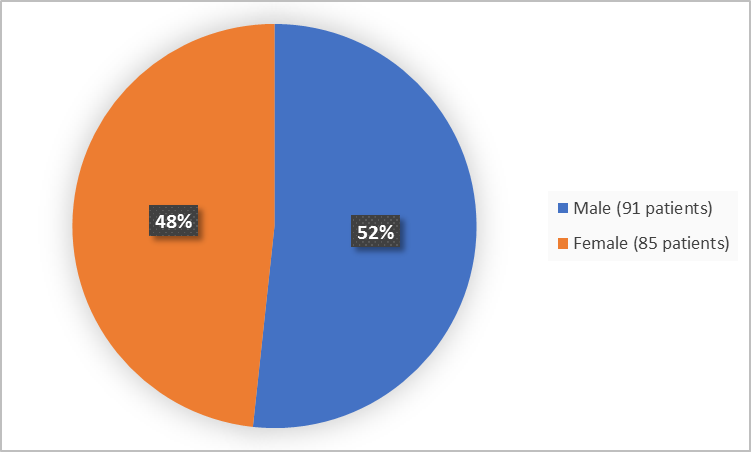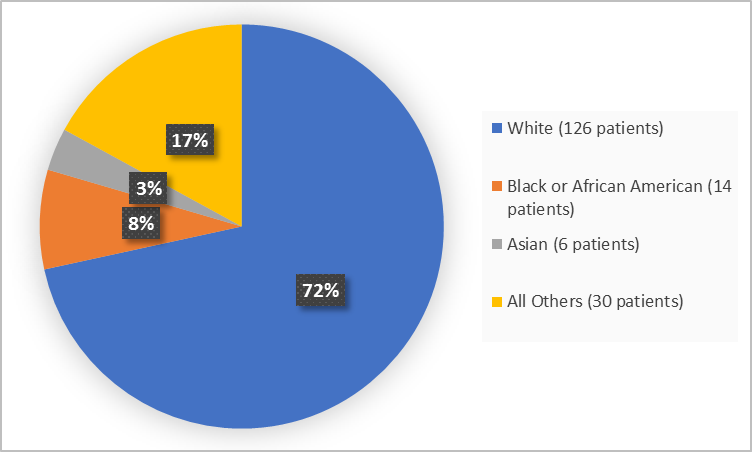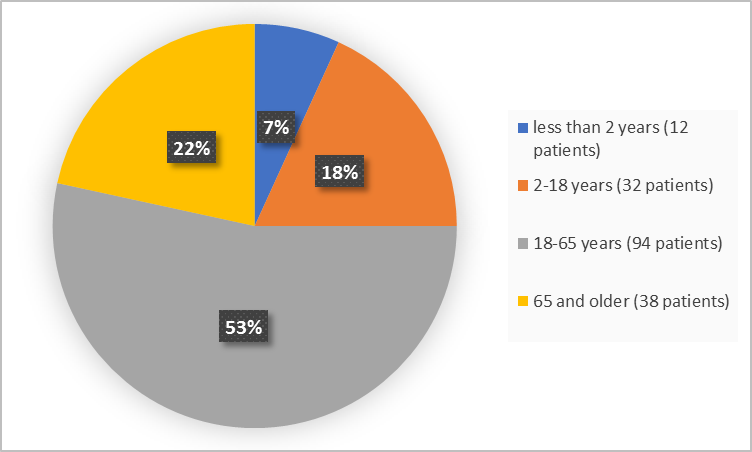Drug Trials Snapshots: VITRAKVI
HOW TO USE THIS SNAPSHOT
The information provided in Snapshots highlights who participated in the clinical trials that supported the FDA approval of this drug, and whether there were differences among sex, race, and age groups. The “MORE INFO” bar shows more detailed, technical content for each section. The Snapshot is intended as one tool for consumers to use when discussing the risks and benefits of the drugs.
LIMITATIONS OF THIS SNAPSHOT:
Do not rely on Snapshots to make decisions regarding medical care. Always speak to your health provider about the risks and benefits of a drug. Refer to VITRAKVI Prescribing Information for complete information.
VITRAKVI (larotrectinib)
vi trak vee
Bayer HealthCare Pharmaceuticals Inc.
Approval date: November 26, 2018
DRUG TRIALS SNAPSHOT SUMMARY:
What is the drug for?
VITRAKVI is a drug used to treat adult and pediatric patients whose cancers have a specific genetic feature (biomarker). It is to be used for patients with solid tumors that:
- are caused by certain abnormal NTRK genes and
- have spread or if surgery to remove their cancer is likely to cause severe complications, and
- there is no acceptable treatment, or the cancer grew or spread on other treatment.
How is this drug used?
VITRAKVI is a capsule or liquid usually taken by mouth 2 times a day.
What are the benefits of this drug?
Seventy-five percent of all patients who received VITRAKVI experienced complete or partial shrinkage of their tumors which lasted for more than 6 months for 73% of them.
VITRAKVI was approved under FDA’s accelerated approval program, which provides earlier patient access to a promising new drug while the company continues to conduct clinical trials to confirm that the drug works well.
What are the benefits of this drug (results of trials used to assess efficacy)?
The tables below summarize efficacy results for the clinical trials based on overall response rate and the type of tumor.
Table 2. Efficacy Results for Patients with Solid Tumors Harboring NTRK Gene Fusions
|
Efficacy Parameter |
VITRAKVI |
|---|---|
|
Overall response rate (95% CI) |
75% (61%, 85%) |
|
Complete response rate |
22% |
|
Partial response rate* |
53% |
|
Duration of response** |
N = 41 |
|
Range (months) |
1.6+, 33.2+ |
|
% with duration ≥ 6 months |
73% |
|
% with duration ≥ 9 months*** |
63% |
|
% with duration ≥ 12 months**** |
39% |
+ Denotes ongoing response
*Includes one pediatric patient with unresectable infantile fibrosarcoma who underwent resection following partial response and who remained disease-free at data cutoff.
**Median duration of response not reached at time of data cutoff
***3 patients with an ongoing response were followed < 9 months from onset of response.
****10 patients with an ongoing response were followed < 12 months from onset of response.
VITRAKVI Prescribing Information
Table 3. Efficacy Results by Tumor Type
|
Tumor Type |
Patients |
ORR |
DOR |
|
|---|---|---|---|---|
|
% |
95% CI |
Range |
||
|
Soft tissue sarcoma |
11 |
91% |
(59%, 100%) |
3.6, 33.2+ |
|
Salivary gland |
12 |
83% |
(52%, 98%) |
7.7, 27.9+ |
|
Infantile fibrosarcoma |
7 |
100% |
(59%, 100%) |
1.4+, 10.2+ |
|
Thyroid |
5 |
100% |
(48%, 100%) |
3.7, 27.0+ |
|
Lung |
4 |
75% |
(19%, 99%) |
8.2, 20.3+ |
|
Melanoma |
4 |
50% |
NA |
1.9, 17.5+* |
|
Colon |
4 |
25% |
NA |
5.6* |
|
Gastrointestinal stromal tumor |
3 |
100% |
(29%, 100%) |
9.5, 17.3 |
|
Cholangiocarcinoma |
2 |
SD, NE |
NA |
NA |
|
Appendix |
1 |
SD |
NA |
NA |
|
Breast |
1 |
PD |
NA |
NA |
|
Pancreas |
1 |
SD |
NA |
NA |
ORR = Overall response rate; DOR = duration of response; NA = not applicable due to small numbers or lack of response; CR = complete response; PR = partial response; NE = not evaluable; SD = stable disease; PD = progressive disease
+ Denotes ongoing response; * Observed values at data cutoff, not a range
VITRAKVI Prescribing Information
Were there any differences in how well the drug worked in clinical trials among sex, race and age?
- Sex: VITRAKVI worked similarly in men and women.
- Race: The majority of patients in the clinical trial were White. Differences in response to VITRAKVI among races could not be determined.
- Age: The majority of patients in the clinical trial were younger than 65 years of age. Differences in response to VITRAKVI between patients below and above 65 years of age could not be determined.
Were there any differences in how well the drug worked in clinical trials among sex, race, and age groups?
The table below summarizes overall response rate by subgroups. Results should be interpreted with caution given the small sample size overall, and the limited number of patients in each subgroup.
Table 4. Subgroup Analyses of Overall Response Rate
|
Subgroup |
# Patients |
n (%) |
95%CI |
|
|---|---|---|---|---|
|
Sex |
||||
|
Male |
29 |
25 (86.2%) |
(68.3%, 96.1%) |
|
|
Female |
26 |
16 (61.5%) |
(40.6%, 79.8%) |
|
|
Race |
||||
|
White |
37 |
26 (70.3%) |
(53%, 84.1%) |
|
|
Asian |
2 |
2 (100%) |
NA |
|
|
Black |
2 |
0 (0%) |
NA |
|
|
All others |
14 |
13 (92.9%) |
(66.1%, 98.8%) |
|
|
Age |
||||
|
<65 years |
43 |
35 (81.4%) |
(66.6%, 91.6%) |
|
|
Infants & Toddlers (<2 years) |
6 |
6 (100%) |
(54.1%, 100%) |
|
|
Children (2 to <12 years) |
6 |
6 (100%) |
(54.1%, NA) |
|
|
Adolescents (16 to <18 years) |
0 |
0 |
NA |
|
|
Adults (18 to <65 years) |
31 |
23 (74.2%) |
(55.4%, 88.1%) |
|
|
>=65 years |
12 |
6 (50%) |
(21.1%, 78.9%) |
|
CI = confidence interval; NA = not applicable
FDA Review
What are the possible side effects?
VITRAKVI may cause serious side effects, including nervous system problems and liver damage.
The most common side effects of VITRAKVI are tiredness, nausea, dizziness, vomiting, cough, increased liver enzymes, constipation and diarrhea.
What are the possible side effects (results of trials used to assess safety)?
The table below summarizes adverse reactions that occurred in the clinical trial in ≥10% of patients treated in VITRAKVI.
Table 5. Adverse Reactions Occurring in ≥10% of Patients Treated with VITRAKVI
|
Adverse Reaction |
VITRAKVI |
|
|---|---|---|
|
All Grades* |
Grade 3-4** |
|
|
General |
||
|
Fatigue |
37 |
3 |
|
Pyrexia |
18 |
1 |
|
Edema peripheral |
15 |
0 |
|
Gastrointestinal |
||
|
Nausea |
29 |
1 |
|
Vomiting |
26 |
1 |
|
Constipation |
23 |
1 |
|
Diarrhea |
22 |
2 |
|
Abdominal pain |
13 |
2 |
|
Nervous System |
||
|
Dizziness |
28 |
1 |
|
Headache |
14 |
0 |
|
Respiratory, Thoracic and Mediastinal |
||
|
Cough |
26 |
0 |
|
Dyspnea |
18 |
2 |
|
Nasal congestion |
10 |
0 |
|
Investigations |
||
|
Increased weight |
15 |
4 |
|
Musculoskeletal and Connective Tissue |
||
|
Arthralgia |
14 |
1 |
|
Myalgia |
14 |
1 |
|
Muscular weakness |
13 |
0 |
|
Back pain |
12 |
1 |
|
Pain in extremity |
12 |
1 |
|
Metabolism and Nutrition |
||
|
Decreased appetite |
13 |
2 |
|
Vascular |
||
|
Hypertension |
11 |
2 |
|
Injury, Poisoning and Procedural Complications |
||
|
Fall |
10 |
1 |
* National Cancer Institute-Common Terminology Criteria for Adverse Events (NCI-CTCAE) v 4.03
** One Grade 4 adverse reaction of pyrexia
VITRAKVI Prescribing Information
The table below summarizes laboratory abnormalities in the clinical trial.
Table 6. Laboratory Abnormalities Occurring in ≥ 5% Patients Treated with VITRAKVI
|
Laboratory Abnormality |
VITRAKVI* |
|
|---|---|---|
|
All Grades** |
Grade 3-4 |
|
|
Chemistry |
||
|
Increased ALT |
45 |
3 |
|
Increased AST |
45 |
3 |
|
Hypoalbuminemia |
35 |
2 |
|
Increased alkaline phosphatase |
30 |
3 |
|
Hematology |
||
|
Anemia |
42 |
10 |
|
Neutropenia |
23 |
7 |
*Denominator for each laboratory parameter is based on the number of patients with a baseline and post-treatment laboratory value available which ranged from 170 to 174 patients.
** NCI-CTCAE v 4.03
VITRAKVI Prescribing Information
Were there any differences in side effects among sex, race and age?
- Sex: The occurrence of side effects was similar in men and women.
- Race: The majority patients in the clinical trial were White. Differences in side effects among races could not be determined.
- Age: The majority of patients in the clinical trial were younger than 65 years of age. Differences in side effects between patients below and above 65 years of age could not be determined.
Were there any differences in side effects of the clinical trials among sex, race, and age groups?
Tables 7-9 below summarize selected adverse events that occurred in the clinical trials by subgroups.
Table 7. Subgroup Analysis of Adverse Events by Sex
|
Adverse Event |
VITRAKVI (N=176) |
|
|---|---|---|
|
Male (N=91) |
Female (N=85) |
|
|
Any TEAE |
90 (99) |
83 (98) |
|
Increased ALT |
28 (31) |
17 (20) |
|
Increased AST |
27 (30) |
18 (21) |
Table 8. Subgroup Analysis of Adverse Events by Race
|
Adverse Event |
VITRAKVI ( N=176) |
||
|---|---|---|---|
|
White (N=126) |
Black or African American (N=14) |
Asian (N=6) |
|
|
Any TEAE |
125 (99) |
14 (100) |
5 (83) |
|
Increased ALT |
21 (28) |
1 (20) |
3 (60) |
|
Increased AST |
19 (26) |
1 (20) |
3 (60) |
Table 9. Subgroup Analysis of Adverse Events by Age
|
Adverse Event |
VITRAKVI (N=176) |
|
|---|---|---|
|
<18 years (N=44) |
≥18 years (N=132) |
|
|
Any TEAE |
42 (95) |
131 (99) |
|
Increased ALT |
19 (43) |
26 (20) |
|
Increased AST |
17 (39) |
28 (21) |
TEAE=treatment-emergent adverse event
Clinical Trial Report
WHO WAS IN THE CLINICAL TRIALS?
Who participated in the clinical trials?
The FDA approved VITRAKVI based on the evidence from three clinical trials of 176 patients with various types of solid tumors (Trial 1 / NCT02122913; Trial 2 / NCT02637687; and Trial 3 / NCT02576431). The trials were conducted at sites in the United States, Europe and Singapore.
Patients who provided data for the benefit of VITRAVI (efficacy population) are presented in Table 10 under MORE INFO.
Patients that provided data for the side effects of VIKTRAVI (safety population) are presented below.
Figure 1 below summarizes how many patients were in the clinical trials by sex.
Figure 1. Baseline Demographics by Sex (safety population)
Clinical Trial Data
Figure 2 and Table 1 below summarize the percentage of patients in the clinical trials by race.
Figure 2. Baseline Demographics by Race (safety population)
Clinical Trial Data
Table 1. Demographics of Trial by Race (safety population)
|
Race |
Number of Patients |
Percentage |
|---|---|---|
|
White |
126 |
72 |
|
Black or African American |
14 |
8 |
|
Asian |
6 |
3 |
|
Other* |
23 |
13 |
|
Not Reported |
7 |
4 |
*includes American Indian or Alaska Native, Native Hawaiian or other Pacific Islander, Multiple and Other
Clinical Trial Data
Figure 3 below summarizes the percentage of patients in the clinical trials by age.
Figure 3. Baseline Demographics by Age (safety population)
Clinical Trial Data
Who participated in the trials?
Table 10 below summarizes patient demographics.
Table 10. Baseline Demographics of Patients in the Clinical Trials
|
Demographic Parameter |
Safety Population |
|
|---|---|---|
|
Sex, n (%) |
||
|
Male |
29 (53) |
91 (52) |
|
Female |
26 (47) |
85 (48) |
|
Race, n (%) |
||
|
White |
37 (67) |
126 (72) |
|
Black or African American |
2 (4) |
14 (8) |
|
Asian |
2 (4) |
6 (3) |
|
American Indian or Alaska Native |
1(2) |
1 (1) |
|
Native Hawaiian or other Pacific Islander |
1 (2) |
1 (1) |
|
Multiple |
1 (2) |
1 (1) |
|
Other |
8 (15) |
20 (11) |
|
Not Reported |
2 (4) |
7 (4) |
|
Age (years) |
||
|
Range |
0.3, 76.0 |
0.1,82.0 |
|
Median |
45.0 |
51.0 |
|
Age Group, n (%) |
||
|
<2 years |
6 (11) |
12 (7) |
|
2-11 years |
6 (11) |
19 (11) |
|
12-18 years |
0 (0) |
13 (7) |
|
18-65 years |
31 (56) |
94 (53) |
|
≥65 years |
12 (22) |
38 (21) |
|
Ethnicity, n (%) |
||
|
Hispanic |
4 (7) |
19 (11) |
|
Non-Hispanic |
38 (69) |
135 (77) |
|
Unknown/Not Reported |
13 (24) |
22 (12) |
Clinical Trial Data
How were the trials designed?
The benefit and side effects of VITRAKVI were evaluated in three trials. Most enrolled patients had an unresectable or metastatic solid tumor with abnormal NTRK genes and no satisfactory alternative treatment options, or disease progression following treatment. The most common types of tumors were soft tissue sarcoma, salivary gland cancer, lung cancer, thyroid cancer, colon cancer, and infantile fibrosarcoma.
Patients received VITRAKVI until either tumor progression or intolerable side effects.
The benefit of VITRAKVI was evaluated by measuring the percentage of patients who achieved complete or partial shrinkage of their tumors (overall response rate) and by measuring the duration of that benefit (duration of response).
How were the trials designed?
The safety and efficacy of VITRAKVI were established in three multicenter, open-label, single-arm clinical trials that included an adult dose-finding single arm trial and a pediatric dose-finding single arm trial, and a single arm trial designed to evaluate the effectiveness of VITRAKVI by assessing overall response rate and durability of response. All patients had a metastatic solid tumor with a NTRK gene fusion and no satisfactory alternative treatment options, disease progression following treatment, or would have required surgical resection was likely to result in severe morbidity. The most common cancers were soft tissue sarcoma (16%), salivary gland tumors (11%), lung (10%), thyroid (9%), colon (8%), and infantile fibrosarcoma (8%).
Most adults (80%) received VITRAKVI 100 mg orally twice daily and 68% of pediatric patients received VITRAKVI 100 mg/m2 twice daily up to a maximum dose of 100 mg twice daily.
The major efficacy outcome measures were overall response rate (ORR) and duration of response (DOR), as determined by a blinded independent review committee (BIRC) according to Response Evaluation Criteria in Solid Tumors (RECIST) v1.1.
GLOSSARY
CLINICAL TRIAL: Voluntary research studies conducted in people and designed to answer specific questions about the safety or effectiveness of drugs, vaccines, other therapies, or new ways of using existing treatments.
COMPARATOR: A previously available treatment or placebo used in clinical trials that is compared to the actual drug being tested.
EFFICACY: How well the drug achieves the desired response when it is taken as described in a controlled clinical setting, such as during a clinical trial.
PLACEBO: An inactive substance or “sugar pill” that looks the same as, and is given the same way as, an active drug or treatment being tested. The effects of the active drug or treatment are compared to the effects of the placebo.
SUBGROUP: A subset of the population studied in a clinical trial. Demographic subsets include sex, race, and age groups.



